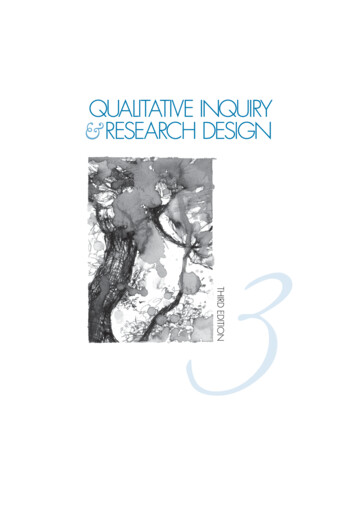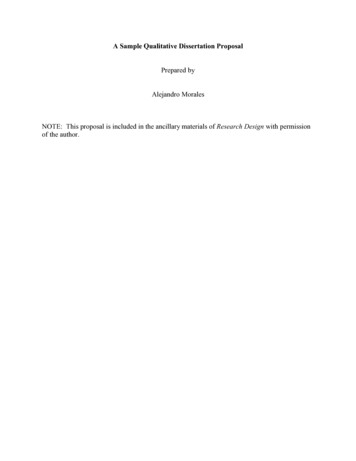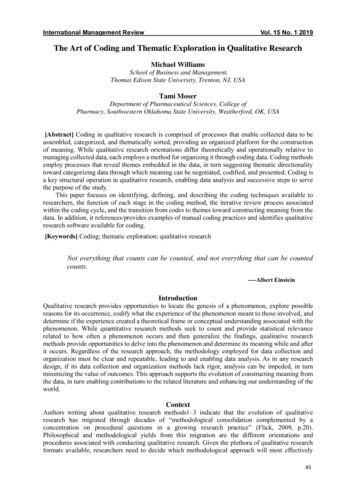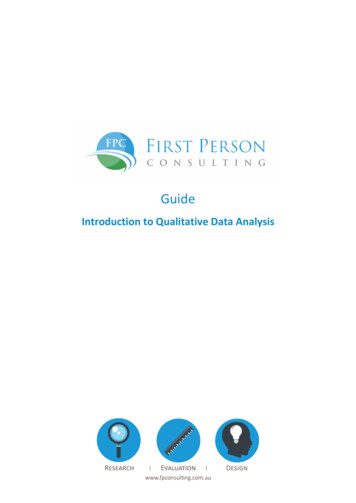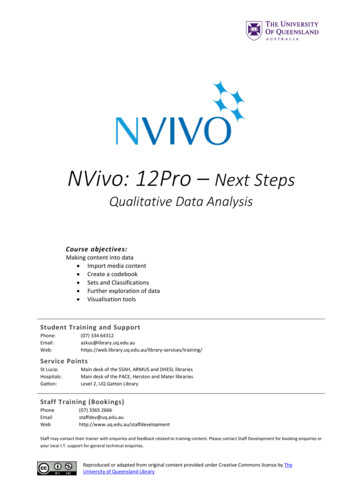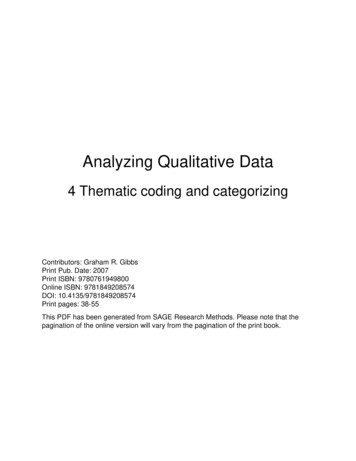
Transcription
Analyzing Qualitative Data4 Thematic coding and categorizingContributors: Graham R. GibbsPrint Pub. Date: 2007Print ISBN: 9780761949800Online ISBN: 9781849208574DOI: 10.4135/9781849208574Print pages: 38-55This PDF has been generated from SAGE Research Methods. Please note that thepagination of the online version will vary from the pagination of the print book.
RMIT UniversityCopyright 2012SAGE Publications, Inc.4 Thematic coding and categorizing Codes and codingThe mechanics of codingData-driven or concept-driven?What to codeRetrieving text from codesGrounded theoryChapter objectivesAfter reading this chapter, you should see the central role of coding in qualitative analysis;see from the close examination of an example the importance of creatingcodes that are analytic and theoretical and not merely descriptive; andknow two techniques that can be used to promote the move from descriptionto analysis: constant comparison and line-by-line coding.Codes and codingCoding is how you define what the data you are analyzing are about. It involvesidentifying and recording one or more passages of text or other data items such as theparts of pictures that, in some sense, exemplify the same theoretical or descriptive idea.Usually, several passages are identified and they are then linked with a name for thatidea – the code. Thus all the text and so on that is about the same thing or exemplifiesthe same thing is coded to the same name. Coding is a way of indexing or categorizingthe text in order to establish a framework of thematic ideas about it (see Box 4.1 for adiscussion of these terms). Coding in this way enables two forms of analysis.2.You can retrieve all the text coded with the same label to combine passagesthat are all examples of the same phenomenon, idea, explanation or activity.Page 2 of 22Analyzing Qualitative Data: 4 Thematic coding andcategorizingSage Research Methods
RMIT UniversityCopyright 20124.SAGE Publications, Inc.This form of retrieval is a very useful way of managing or organizing the data,and enables the researcher to examine the data in a structured way.You can use the list of codes, especially when developed into a hierarchy, toexamine further kinds of analytic questions, such as relationships betweenthe codes (and the text they code) and case-by-case comparisons. This willbe examined in Chapter 6.Box 4.1 Code, index, category or theme?When you first come across it, the idea of a code might seem rather mysterious.You probably first think about it in terms of secret codes and ciphers. For others, theassociation with computer code and programming might come to mind. As it is usedhere, codes are neither secretive nor to do with programming. They are simply a way oforganizing your thinking about the text and your research notes.Writers on qualitative analysis use a variety of terms to talk about codes and coding.Terms such as indices, themes and categories are used. Each reflects an importantaspect of coding. Richie and Lewis prefer the term ‘index’ as this captures the sensein which codes refer to one or more passages in the text about the same topic in theway that entries in a book index refer to passages in the book (Ritchie et al., 2003). Inphenomenological analysis, a term that is used instead of codes is ‘themes’ (Smith,1995; King, 1998). Again this captures something of the spirit of what is involved inlinking sections of text with thematic ideas that reveal the person's experience of theworld. Dey (1993) uses ‘category’, which indicates another aspect of coding. Theapplication of names to passages of text is not arbitrary, it involves a deliberate andthoughtful process of categorizing the content of the text. Coding means recognizingthat not only are there different examples of things in the text but that there are differenttypes of things referred to.To add confusion to this, quantitative researchers also use the term ‘coding’ whenassigning numbers to survey question answers or categorizing answers to open-endedquestions. The latter is somewhat like qualitative coding, but is usually done in orderto count the categorized responses, which is not the prime motivation of qualitativeresearchers.Page 3 of 22Analyzing Qualitative Data: 4 Thematic coding andcategorizingSage Research Methods
RMIT UniversityCopyright 2012SAGE Publications, Inc.The structured list of codes and the rules for their application (their definitions) thatresult from qualitative analysis are sometimes referred to as a coding frame. Again,this is confusing, since quantitative researchers use this to refer to the listing that tellsthem what numeric value to assign to different answers in surveys so that they canbe counted. For that reason I have avoided the term. Others use the term ‘thematicframework’ (Ritchie et al., 2003) or ‘template’ (King, 1998). Here I just refer to thelist of codes, or the codebook, a term used by many other analysts. ‘Book’ suggestssomething more weighty than just a list and indeed it is good practice that you shouldkeep more than just a list. The codebook is something that should be kept separatefrom any coded transcripts. It should include not only the current and complete list ofyour codes, arranged hierarchically if appropriate, but also a definition for each alongwith any memos or analytic notes about the coding scheme that you have written.Coding is easiest using a transcript. It is possible to code directly from an audio orvideo recording or from rough field notes, but it is neither easy to do this nor is it easyto retrieve the sections of recording or notes that have been coded when you needthem. (The exception to this is when you are using CAQDAS and digital video or audio.Then the software makes it much easier to retrieve the sections of video or audio thatyou have coded.) In fact, a lot of the time, coding is best done with an electronic textfile using dedicated analysis software. I shall examine this in Chapter 9, but here Ishall explain techniques that can be done with a paper transcript. I actually use bothpaper-based and computer-based approaches myself. I find that paper allows me thekinds of creativity, flexibility and ease of access that is important at the early stagesof analysis. I then transfer the coding ideas into the electronic version of the projectin order to continue the analysis. Do not be afraid about using either just paper or justsoftware or both. As long as you make certain preparations (like introducing your datainto the software before you produce printed copy to work on), there is nothing to stopyou moving, when you want to, from paper to the software. Of course, you don't have touse software at all. For most of the last century, those undertaking qualitative analysisdid not or could not use software. Most of the classic studies using qualitative researchwere undertaken without electronic assistance.Page 4 of 22Analyzing Qualitative Data: 4 Thematic coding andcategorizingSage Research Methods
RMIT UniversityCopyright 2012SAGE Publications, Inc.Code definitionsCodes form a focus for thinking about the text and its interpretation. The actual codedtext is just one aspect of that. For this reason it is important that as early as you can youwrite some notes about each code you develop. In the previous chapter I introducedthe idea of writing memos as an important way of recording the development of youranalytic thinking. A key function of such memos is to note the nature of a code andthe thinking that lies behind it and to explain how the code should be applied or whatkinds of text, images, and so on should be linked to the code. Keeping such a record isimportant for two reasons:2.4.It will help you apply the code in a consistent way. Without having to rereadall the text already coded to this name, you will be able to decide if any newtext should really be coded there.If you are working in a team, it will enable you to share your codes withothers for them to use and, if they have done the same, to use theirs. It isquite likely, if more than one member of the team is coding, that more thanone person will come up with similar coding ideas. Having memos about thecodes will enable you to tell if the codes are, in fact, identical or not.Keep your code memos in one or more word-processing files (so you can easily editthem or print them out) or use large filing cards to record the details. Typically you willneed to record: The label or name of the code that you have used in marking up and codingthe transcript.Who coded it – the name of the researcher (not needed if you are workingalone).The date when the coding was done or changed.Definition of the code – a description of the analytic idea it refers to and waysof ensuring that the coding is reliable, that is, carried out in a systematic andconsistent way.Any other notes of your thinking about the code, for example, ideas youmay have about how it relates to other codes or a hunch that maybe the textPage 5 of 22Analyzing Qualitative Data: 4 Thematic coding andcategorizingSage Research Methods
RMIT UniversityCopyright 2012SAGE Publications, Inc.coded here could actually be split between two different codes (see Box 3.2for more ideas).The mechanics of codingThose new to coding often find one of the most challenging things to begin with isidentifying chunks of text and working out what codes they represent in a way that istheoretical and analytic and not merely descriptive. This involves careful reading of thetext and deciding what it is about. In the visual arts the term ‘intensive seeing’ is used torefer to the way that we can pay close attention to all the things we can see, even thecommonplace and ordinary. In the same way, you need to undertake ‘intensive reading’when coding. Charmaz suggests some basic questions to ask as you undertake thisintensive reading that will help you get started: What is going on?What are people doing?What is the person saying?What do these actions and statements take for granted?How do structure and context serve to support, maintain, impede or changethese actions and statements? (Charmaz, 2003, pp. 94–5)An exampleTo illustrate this initial stage, consider the following example. It is taken from a studyof carers for people with dementia and is an interview with Barry, who is now lookingafter his wife, who has Alzheimer's disease. The interviewer has just asked Barry, ‘Haveyou had to give anything up that you enjoyed doing that was important to you?’, and hereplies:2.4.6.8.BARRYWell, the only thing that we've really given up is – well we used togo dancing. Well she can't do it now so I have to go on my own,that's the only thing really. And then we used to go indoor bowlingPage 6 of 22Analyzing Qualitative Data: 4 Thematic coding andcategorizingSage Research Methods
RMIT UniversityCopyright 201210.12.14.16.18.SAGE Publications, Inc.at the sports centre. But of course, that's gone by the board now. Sowe don't go there. But I manage to get her down to works club, justdown the road on the occasional Saturdays, to the dances. She'll sitand listen to the music, like, stay a couple of hours and then she'shad enough. And then, if it's a nice weekend I take her out in the 10 car.DescriptionAt one level this is a very simple reply. In lines 2 to 6 Barry gives two examples of thingsthat he and Beryl used to enjoy together, dancing and indoor bowling, then, withoutprompting, he lists two things that they still do together, visiting dances at the works cluband going out for a drive. So a first idea is to code lines 2 to 4 to the code ‘Dancing’,lines 4 to 6 to ‘Indoor bowling’, 6 to 9 to ‘Dances at works club’ and 9 to 10 to ‘Drivetogether’. Such coding might be useful if you are analyzing interviews with lots of carersand you wanted to examine the actual activities given up and those still done togetherand compare them between couples. Then retrieving all the text coded at codes aboutsuch activities would enable you to list and compare what people said about them.CategorizationHowever, such coding is simply descriptive; there are usually better ways to categorizethe things mentioned and there are other things indicated by Barry's text. In analysisyou need to move away from descriptions, especially using respondent's terms, toa more categorical, analytic and theoretical level of coding. For example, you cancode the text about dancing and indoor bowling together at a code ‘Joint activitiesceased’, and text on works club dances and driving together to the code ‘Joint activitiescontinuing’. Assuming you have done the same in other interviews, you can nowretrieve all the text about what couples have given up doing and see if they have thingsin common. In so doing you have begun to categorize the text.Page 7 of 22Analyzing Qualitative Data: 4 Thematic coding andcategorizingSage Research Methods
RMIT UniversityCopyright 2012SAGE Publications, Inc.Analytic codesThinking about this suggests another way to code the text. Both dancing and bowlingare physical activities involving some degree of skilled movement. Clearly Beryl haslost that, so we could code lines 2 to 6 to the code ‘Loss of physical co-ordination’.This code is now slightly more analytic than those we started with, which just repeatedBarry's descriptions. Barry does not talk about loss of physical co-ordination, but it isimplied in what he says. Of course you need to be careful. This is an interpretation,based, here, on very little evidence. You need to look for other examples in Barry'sinterview of the same thing and perhaps other evidence in what he says of Beryl'sinfirmity.Another thing to notice about this text is the way Barry changes from using ‘we’ aboutwhat they used to do together, to saying ‘I’ when he turns to the things they do now.This suggests another pair of analytic codes, one about joint activity with a sense ofbeing a couple, the other about activity where the carer is just doing things for hispartner. You might code these as ‘Togetherness’ and ‘Doing for’. Note that these codesdo not simply code what happened, but rather suggest the way in which Barry thoughtabout, or conceptualized, these things.Other things you might have noticed about the passage that might be candidates forcodes include Barry's rhetorical use of ‘Well’ in lines 2 and 3. He says it three times.Is this an indication of a sense of resignation, loss or regret? Again, from such a shortpassage it is not clear. But you might code it ‘Resignation’ for now and later see if it isconsistent with other text of Barry's you have coded to ‘Resignation’. It is interesting tonote that Barry says he still goes dancing, on his own. A different interpretation of thisuse of ‘well’ and the fact that it is the first thing that Barry mentions, is that dancing wasa key thing that he and Beryl did together as a couple. You might therefore think that itis a kind of core or central activity of the couple, something that was central to their lifetogether as a couple. Again, it would be useful to examine other carers to see if thereare similar defining activities and to see if this identifies any differences between carers.Perhaps carers where the defining activities have been less affected by Alzheimer's aredifferent from those where it has.Page 8 of 22Analyzing Qualitative Data: 4 Thematic coding andcategorizingSage Research Methods
RMIT UniversityCopyright 2012SAGE Publications, Inc.In summary, here are the codes that might be used to code the passage by Barry.2.4.6.Descriptive codes: ‘Dancing’, ‘Indoor bowling’, ‘Dances at works club’, ‘Drivetogether’.Categories: ‘Joint activities ceased’, ‘Joint activities continuing’.Analytic codes: ‘Loss of physical co-ordination’, ‘Togetherness’, ‘Doing for’,‘Resignation’, ‘Core activity’.Of course, it is unlikely that you would use all these codes to code just one shortpassage like this, but I have used them here to illustrate the way you need to movefrom descriptive coding, close to the respondent's terms, to categorization and to moreanalytic and theoretical codes. Also notice that I have used the codes only once inthis short text. Normally, you would look through the rest of the text to see if there areany more passages that can be coded to the same code and do the same with otherparticipants.How you develop these thematic codes and which of them you focus on will depend onthe aim of the research. In many cases, research is driven by funding bodies and whatyou have agreed with the funders that you will do. For example, if the research on thosesuffering from Alzheimer's disease was funded by the bodies that provide services tocarers, then you might focus on the themes ‘Doing for’ and ‘Joint activities’. On the otherhand, if you were doing a PhD on the social psychology of couples, you might focus on‘Core activity’ and ‘Togetherness’.Marking the codingWhen using paper, coding is done by jotting the code name in the margin or by markingtext with colour (either in the margin or using highlighter pens). Figure 4.1 shows someof these ways of indicating this coding on the transcript. There are boxes with linkednames (I used arrows), shading (e.g. with a highlighter pen) and linked code name. Theright-hand margin is used with brackets to indicate the lines coded. I have circled orhighlighted some key words or terms such as emotive words, unusual terms, metaphorsand words used for emphasis.Page 9 of 22Analyzing Qualitative Data: 4 Thematic coding andcategorizingSage Research Methods
RMIT UniversityCopyright 2012SAGE Publications, Inc.Data-driven or concept-driven?The construction of codes in a codebook is an analytic process. It is the building up ofa conceptual schema. Although in the illustrations I have discussed the codes werederived from and are grounded in the data, it is possible to build a codebook withoutinitial reference to the data collected.Concept-driven codingThe categories or concepts the codes represent may come from the research literature,previous studies, topics in the interview schedule, hunches you have about what isgoing on, and so on. It is possible to construct a collection of codes in a codebookwithout, at first, using them to code the data. Such a view is taken by Ritchie et al.(2003) in their advocacy of framework analysis. In framework analysis, before applyingcodes to the text, the researcher is encouraged to build up a list of key thematic ideas.These can be taken from the literature and previous research but are also generatedby reading through at least some of the transcripts and other documents such as fieldnotes, focus groups and printed documents. A similar view is taken by King (1998), whorecommends the construction of a template, using similar sources of inspiration, whichis a hierarchical arrangement of potential codes. In both King's template analysis andframework analysis, coding consists of the identification of chunks of text that exemplifythe codes in this initial list. However, all these authors recognize that the researcherwill need to amend the list of codes during analysis as new ideas and new ways ofcategorizing are detected in the text.FIGURE 4.1 Barry's reply with codingPage 10 of 22Analyzing Qualitative Data: 4 Thematic coding andcategorizingSage Research Methods
RMIT UniversityCopyright 2012SAGE Publications, Inc.Data-driven codingThe opposite of starting with a given list of codes is to start with none. This approach isusually called open coding (see the discussion later in this chapter), perhaps becauseone tries to do it with an open mind. Of course, no one starts with absolutely no ideas.The researcher is both an observer of the social world and a part of that same world.We all have ideas of what we might expect to be happening and as social scientistswe are likely to have more than most as a result of our awareness of theoretical ideasand empirical research. Nevertheless one can try, as far as possible, not to startwith preconceptions. Simply start by reading the texts and trying to tease out what ishappening. Such an approach is taken by the advocates of grounded theory (Glaserand Strauss, 1967; Strauss, 1987; Glaser, 1992; Strauss and Corbin, 1997; Charmaz,2003) and by many phenomenologists in their concept of bracketing – setting asidepresuppositions, prejudices and preliminary ideas about phenomena (Moustakas, 1994;Maso, 2001; Giorgi and Giorgi, 2003). But even they accept that a complete tabula rasaapproach is unrealistic. The point is that, as far as possible, one should try to pull outfrom the data what is happening and not impose an interpretation based on pre-existingtheory.These two approaches to generating codes are not exclusive. Most researchers movebackwards and forwards between both sources of inspiration during their analysis. Thepossibility of constructing codes before or separately from an examination of the datawill reflect, to some extent, the inclination, knowledge and theoretical sophisticationof the researcher. If your project has been defined in the context of a clear theoreticalframework, then it is likely that you will have some good ideas about what potentialPage 11 of 22Analyzing Qualitative Data: 4 Thematic coding andcategorizingSage Research Methods
RMIT UniversityCopyright 2012SAGE Publications, Inc.codes you will need. That is not to say that they will be preserved intact throughout theproject, but at least it gives you a starting point for the kinds of phenomena you wantto look for when reading the text. The trick here is not to become too tied to the initialcodes you construct.What to codeThe example of coding I have discussed above is very short and specific to one context– caring for those suffering from dementia. What about interviews, notes and recordingson other topics? What other kind of things can be coded? The answer depends to someextent on the kind of analysis you are intending to do. Some disciplines and theoreticalapproaches like phenomenology, discourse analysis or conversation analysis willrequire that you pay special attention to certain kinds of phenomena in the texts you areexamining.Fortunately, for a very wide range of types of qualitative analysis that includes muchpolicy and applied research and evaluation work as well as interpretive and hermeneuticapproaches, there is a common ground of phenomena that researchers tend to look forin their texts. Some typical examples are listed in Table 4.1. Different authors have adifferent emphasis, but many of the ideas in the table will be useful to any analysis oftexts.Note that many of the examples in this table are rather descriptive. I have given thesebecause it is easier to illustrate the phenomena with concrete examples. However, asI have suggested above, it is necessary to move from descriptions, especially thosecouched simply in terms used by participants, to more general and analytic categories.For example, rather than the event ‘Joining a sports club’ you might want to code thistext to ‘Activity to make friends’ or ‘Commitment to keeping fit’ or even ‘Identity as a fitperson’, which make reference to the more general significance of this event.TABLE 4.1 What can be coded? (with examples)Page 12 of 22Analyzing Qualitative Data: 4 Thematic coding andcategorizingSage Research Methods
RMIT UniversityCopyright 2012Page 13 of 22SAGE Publications, Inc.Analyzing Qualitative Data: 4 Thematic coding andcategorizingSage Research Methods
RMIT UniversityCopyright 2012SAGE Publications, Inc.Retrieving text from codesSo far I have discussed coding mainly as a way of analyzing the content of thetext. However, coding also has another, important purpose, which is to enable themethodical retrieval of thematically related sections of the text. There are severalreasons for this: You can quickly collect together all the text coded in the same way and readit through to see what is at the core of the code.You can examine how, within a case, a coded thematic idea changes or isaffected by other factors.You can explore how categorizations or thematic ideas represented by thecodes vary from case to case, from setting to setting or from incident toincident.Such retrieval activities will help you develop your analysis and your analytic andtheoretical approach. For example, by reading the text you have coded to what might bea rather descriptive code used across several cases, you may discover some deeper,more analytic connection. You can then rename the code and rewrite its definition toindicate this idea, or perhaps create a new code and code relevant text to it.Practical retrievalIn order to retrieve the text to do this, you need to have taken some practical measureswith your coded transcripts. All these kinds of retrieval are easiest if you are usingCAQDAS. I will explore how in Chapter 8. If you are using paper you will need to do twothings: Gather together all the text coded with the same code in one place. Youshould produce many photocopies of your coded transcript so that you cancut up the sheets and store extracts with the same code in separate paperwallets, envelopes or files. If using a word processor, this can be achieved bycopying and pasting the text into separate files for each code.Page 14 of 22Analyzing Qualitative Data: 4 Thematic coding andcategorizingSage Research Methods
RMIT UniversityCopyright 2012 SAGE Publications, Inc.Tag or label each extract (paper slip or electronically cut-and-pasted text)so that you can tell which document it came from. (If you use line numbers,these will tell you whereabouts in the document it came from. However, notethat if you are cutting and pasting in a word processor, line numbering willnot be preserved in the copy. In this case it is best simply to add a referenceto the original line numbers along with the source tag.) If you have just afew documents, then just a couple of initials at the top of each extract toidentify the document will do. But if you have a large number of documents/respondents, then a numbering system will help. A tag consisting of a stringof letters or numbers that indicates not only the identity of the respondent butalso some basic biographical information (like age group, gender and status)will help identify where the original text came from. You might use somethinglike ‘BBm68R’ to indicate the interview with Barry Bentlow who is male, aged68 and retired. Put this tag at the top of each extract or slip.Such retrieval of the text coded by one code should be kept with any memos about thecode so that you can ensure that the definition of the code still makes sense across allthe extracts retrieved. If not you may need to recode some of the text or change thecode definition. You can also check if any of your analytic ideas recorded in the memoelucidate the text you have retrieved or possibly write more in the memo after examiningthe retrieved text.Grounded theoryOne of the most commonly used approaches to coding is grounded theory. Thisapproach has been used extensively across a variety of social science disciplinesand it lies behind the design of much CAQDAS. Its central focus is on inductivelygenerating novel theoretical ideas or hypotheses from the data as opposed to testingtheories specified beforehand. Insofar as these new theories ‘arise’ out of the data andare supported by the data, they are said to be grounded. It is only at a later stage ofthe analysis that these new ideas need to be related to existing theory. In their veryaccessible account of grounded theory, Strauss and Corbin (1990) present manyspecific ideas and techniques for achieving a grounded analysis. They divide codinginto three stages:Page 15 of 22Analyzing Qualitative Data: 4 Thematic coding andcategorizingSage Research Methods
RMIT UniversityCopyright 20122.4.6.SAGE Publications, Inc.Open coding, where the text is read reflectively to identify relevantcategories.Axial coding, where categories are refined, developed and related orinterconnected.Selective coding, where the ‘core category’, or central category that ties allother categories in the theory together into a story, is identified and related toother categories.Open codingThis is the kind of coding where you examine the text by making comparisons andasking questions. Strauss and Corbin also suggest it is important to avoid a label thatis merely a description of the text. You need to try and formulate theoretical or analyticcodes. The actual text is always an example of a more general phenomenon andthe code title should indicate this more general idea. This is the hard part of coding.As you read the text, phrase by phrase, you should constantly ask questions: who,when, where, what, how, how much, why, and so on. This is designed to alert you tothe theoretical issues lying behind the text and to give you a sensitivity to the deepertheoretical levels in them.Constant comparisonThere are also several contrasts one can construct to help understand what mightlie behind the surface text. The idea behind these contrasts or comparisons is to tryto bring out what is distinctive about the text and its content. All too often we are sofamiliar with things that we fail to notice what is significant. Think about comparisonsall the time as you go through doing your coding. This is one aspect of what is referredto as the method of constant comparison (Glaser and Strauss, 1967). Here are someexamples of techniques suggested by Strauss, and Corbin (1990).Page 16 of 22Analyzing Qualitative Data: 4 Thematic coding andcategorizingSage Research Methods
RMIT UniversityCopyright 2012SAGE Publications, Inc.Analysis of word, phrase or sentencePick out one word or phrase that seems significant, then list all its possible meanings.Examine the text to see which apply here. You may find new meanings that were notobvious beforehand.Flip-flop techniqueCompare extremes on a dimension in question. For example, if someone mentionstheir age is a problem in finding work, try to
Page 3 of 22 Analyzing Qualitative Data: 4 Thematic coding and categorizing Sage Research Methods This form of retrieval is a very useful way of managing or organizing the data, and enables the researcher to examine the data in a structured way. 4. You can use the list



